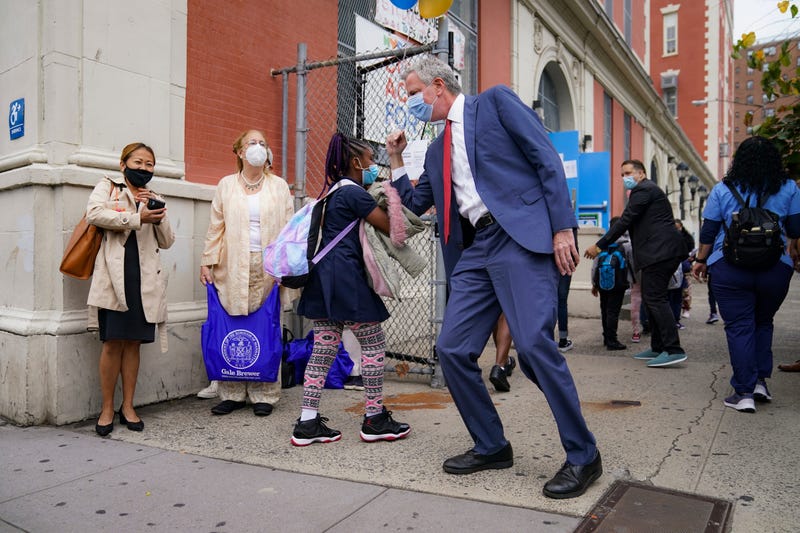
The two largest school districts in the U.S. are rolling out ambitious and costly plans to test students and staff for the coronavirus, bidding to help keep school buildings open amid a rise in infections among the nation's school-age children.
New York City is set to begin testing 10% to 20% of students and staff in every building monthly beginning Thursday, the same day the final wave of the district’s more than 1 million students returns to brick-and-mortar classrooms for the first time in six months.
“Every single school will have testing. It will be done every single month. It will be rigorous,” New York City Mayor Bill de Blasio said in announcing the plan as part of an agreement with the teachers union to avert a strike. At least 79 Department of Education employees have died from the virus.
With an estimated 100,000-120,000 tests expected each month, each costing between $78 and $90, New York City’s school-based testing plan goes well beyond safety protocols seen in most other districts.
Meanwhile, the Los Angeles Unified School District, has launched a similarly comprehensive, $150 million, testing program to help determine when it will be safe to resume in-person instruction. The district began the school year remotely in August for all 600,000 students. The New York and Los Angeles systems are respectively the nation's largest and 2nd-largest school districts.
Leaders in both cities say regular testing is needed in districts of their size and in areas of the country that previously witnessed unnerving surges of the virus.
The coronavirus struck hard at the elderly early in the pandemic and is now increasingly infecting American children and teens in a trend authorities say appears to be fueled by school reopenings and other activities. Children of all ages now make up 10% of all U.S cases, up from 2% in April, the American Academy of Pediatrics reported Tuesday.
The Centers for Disease Control and Prevention said this week that the incidence of COVID-19 in school-age children began rising in early September as many returned to classrooms. Its recommendations emphasize distancing, cleaning and face coverings for most reopening plans — though no requirement for universal testing of students and staff.
As part of the LAUSD plan announced this month, all students and staff will get an initial baseline test in coming weeks to ensure the incidence of COVID-19 is low, and then another test immediately before returning to school, Superintendent Austin Beutner said Monday.
Periodic testing will continue throughout the school year under a collaboration chaired by Beutner and former U.S. Education Arne Duncan that also includes the University of California, Los Angeles, Johns Hopkins and Stanford universities, Microsoft and several health providers.
“Pulling off something like this is almost a miraculous undertaking in and of itself because there are so many things that could go wrong,” said Arlene Inouye, secretary of United Teachers Los Angeles, which negotiated conditions for school nurses tasked with testing, “but what’s really encouraging is that there are a lot of partners in this venture.”
The number of districts relying on some level of testing to keep the virus in check is likely to increase after President Donald Trump this week encouraged governors to prioritize schools when distributing millions of rapid coronavirus tests provided by the federal government.
In western New York, the Niagara Falls City School District did not initially include school-based testing in its reopening plans, reasoning that was the job of hospitals and doctors. But on Wednesday, Superintendent Mark Laurrie was in the process of buying five rapid testing machines for his district, each about $2,500, after shutting down a middle school where three staff members tested positive.
“When you see the impact that has on academics — that’s what we’re here for — then I think there’s a higher calling to do more testing,” Laurrie said. “That way we don’t have to rely on anybody else. We can rely on ourselves.”
There is little if any available data to show how many districts nationwide have adopted in-school virus testing, said Gigi Gronvall, an immunologist and senior scholar at Johns Hopkins University’s Center for Health Security.
Boston Public Schools will offer random virus testing to 5% of teachers weekly, under an agreement with the teachers union. In Rhode Island, a K-12 testing hotline has been set up to field calls and arrange rapid testing for staff and students showing symptoms. In Florida, the Pasco County school district and health department announced three school sites to test people referred by school nurses.
“There’s so many patchwork plans,” said Gronvall, noting there has been no national model for districts to follow.
Gronvall praised the plans to test even those people in school who don’t appear to be sick.
As many as 40% of people infected with COVID-19 exhibit no symptoms.
Los Angeles County Public Health Director Barbara Ferrer cautioned that testing alone does not control infection unless conducted almost daily.
“Testing has a role but testing is not a substitute for the infection control and the distancing and the mask wearing requirements that have to happen at every school building,” Ferrer said.
Positive cases found in New York City schools will trigger set responses, beginning with tracing teams dispatched to the school to figure out who else may have been exposed. A single case will push that student or teacher’s entire class to remote learning until contact tracing is complete. More than one case will mean an entire school will temporarily halt in-person instruction.
“The response might seem really severe to people and it might seem like an extreme response,” said epidemiologist Nadia Abuelezam, an assistant professor at Boston College. “But based on what we’ve seen at other types of schools and specifically colleges and universities now, we know that there is the potential for very rapid transmission in student clusters.”
___
Follow AP coverage of the virus outbreak at https://apnews.com/VirusOutbreak and https://apnews.com/UnderstandingtheOutbreak.
